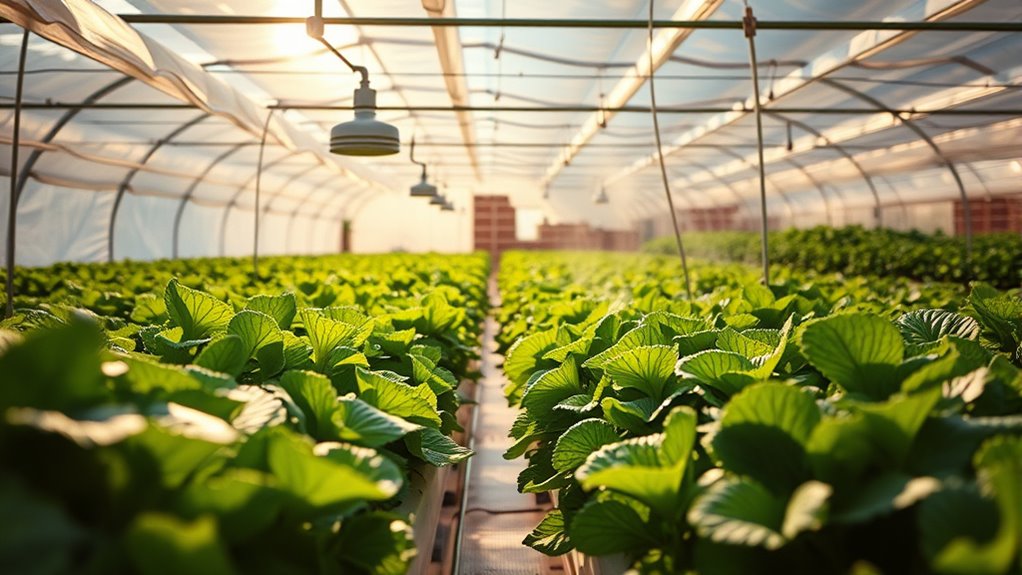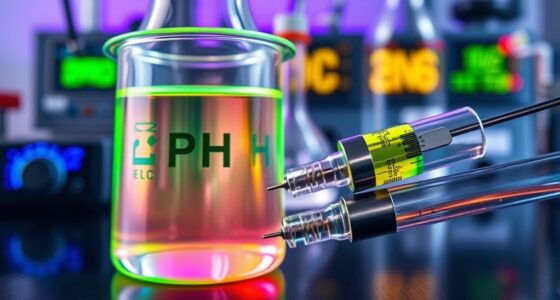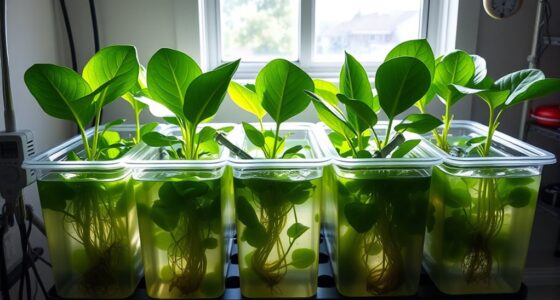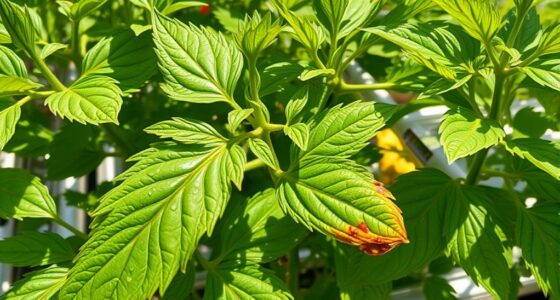To optimize CO2 enrichment in hydro greens, aim for levels between 800 and 1,200 ppm. Going over 1,200 ppm can cause plant stress, leaf burn, and even death, while also creating safety risks for you and your team. Keep an eye on CO2 sensors and adjust gradually to avoid exceeding safe thresholds. If you want to learn how to set the perfect balance without risking your crops or safety, explore further details below.
Key Takeaways
- Maintain CO2 levels between 800-1,200 ppm to optimize plant growth without causing stress or damage.
- Excessive CO2 above 1,200 ppm can lead to leaf burn, inhibited growth, and unsafe conditions for workers.
- Use reliable sensors to monitor CO2 and avoid surpassing safe, optimal concentrations.
- Gradually increase CO2 levels, observing plant response to prevent over-enrichment.
- Ensure proper ventilation and system conditions to safely manage CO2 without buildup or waste.

Enhancing hydro greens with CO2 enrichment can markedly boost their growth and overall yield. When you introduce extra carbon dioxide into your hydroponic system, you’re fundamentally giving your plants more of the essential ingredient they need for photosynthesis. This process allows them to produce energy more efficiently, resulting in faster growth, larger leaves, and increased crop productivity. But while it might seem tempting to push CO2 levels as high as possible to maximize gains, too much can actually harm your plants and disrupt your system. Finding the right balance is key to reaping the benefits without risking adverse effects.
Boost hydro greens with CO2 for faster growth, but keep levels balanced to avoid harm and maximize yield.
In general, maintaining CO2 concentrations between 800 and 1,200 parts per million (ppm) is considered ideal for most hydroponic greens. This range provides a significant boost over ambient levels, which typically hover around 400 ppm, without overwhelming your plants or the environment. You should monitor your CO2 levels closely using reliable sensors to avoid unintended spikes. When levels go too high, plants can experience stress, which can manifest as leaf burn, inhibited growth, or even plant death in extreme cases. Excessive CO2 can also create an unsafe environment for you and anyone else working in the space, as high concentrations pose health risks.
It’s important to remember that CO2 enrichment works best when other growing conditions are ideal. Adequate lighting, proper airflow, and balanced nutrient levels all contribute to how well your plants can utilize the added CO2. If any of these factors are lacking, the plants won’t benefit as much, and you might inadvertently waste resources trying to push CO2 levels higher. Additionally, increasing CO2 without proper ventilation can lead to dangerous buildup, especially in enclosed spaces. That’s why ventilation systems and proper monitoring are essential components of a successful CO2 enrichment strategy.
You should also consider the specific needs of your hydro greens. Leafy greens, such as lettuce or spinach, tend to respond very well to CO2 enrichment, but they still require careful management to avoid overdoing it. Always start at lower levels, observe how your plants react, and gradually increase if needed. Remember, more isn’t always better. Over-enrichment can lead to diminishing returns, and in some cases, harm your crop. The goal is to support rapid, healthy growth without crossing into dangerous or counterproductive territory. By maintaining a balanced approach, you’ll maximize your hydroponic system’s efficiency and ensure a safe, productive environment for your greens.
Furthermore, understanding the relationship between renewable energy sources and sustainable practices can help optimize your overall system efficiency, including CO2 enrichment strategies.
Frequently Asked Questions
What Are the Long-Term Effects of High CO2 Levels on Plant Health?
High CO2 levels can boost plant growth initially, but over time, they may cause issues like reduced nutrient uptake, weaker plant structures, and increased susceptibility to diseases. You might notice plants becoming overly lush but less resilient. Prolonged exposure could also lead to a buildup of harmful byproducts. To keep your plants healthy long-term, monitor CO2 levels carefully and maintain a balanced environment.
How Do Different Hydro Green Varieties Respond to CO2 Enrichment?
Like a symphony responding to the conductor, different hydro green varieties react uniquely to co2 enrichment. Some, like lettuce, thrive with increased CO2, grow faster, and yield more. Others, such as herbs, may show moderate responses or even stress if levels get too high. You should tailor CO2 levels to each variety, observing their growth patterns carefully, so you don’t drown your plants in a flood of excess gas.
Can CO2 Enrichment Improve Nutrient Uptake Efficiency?
Yes, CO2 enrichment can improve your nutrient uptake efficiency. When you increase CO2 levels, your hydro greens can photosynthesize more effectively, leading to faster growth and better nutrient absorption. This means your plants use nutrients more efficiently, reducing waste and potentially boosting yields. Just make sure you don’t go overboard, as excessively high CO2 levels can stress your plants or create safety hazards for your workspace.
What Are the Safety Concerns for Workers During CO2 Supplementation?
A stitch in time saves nine, and safety is key when supplementing CO2. You should guarantee proper ventilation and monitor CO2 levels with reliable detectors to prevent dangerous buildup. Always wear protective gear and train staff on emergency procedures. By staying vigilant and following safety protocols, you can keep workers safe while maximizing the benefits of CO2 enrichment. Remember, safety first keeps your operation running smoothly.
How Does CO2 Enrichment Influence Pest and Disease Resistance?
You might notice that increasing CO2 levels can boost plant growth, which can help plants better resist pests and diseases by strengthening their overall health. However, excessive CO2 can create a humid environment that fosters mold or fungal infections, potentially making plants more vulnerable. Consequently, balance is key: provide enough CO2 to promote resilience without creating conditions that encourage pests or diseases to thrive.
Conclusion
Remember, while boosting CO2 levels can give your hydro greens a leg up, too much can backfire. Think of it like walking a tightrope—you want enough to see results, but not so much that you lose your balance. Stay mindful of your plants’ needs and monitor closely. Striking that sweet spot guarantees your greens thrive without heading down the wrong path. After all, moderation is key to keeping everything running smoothly.










